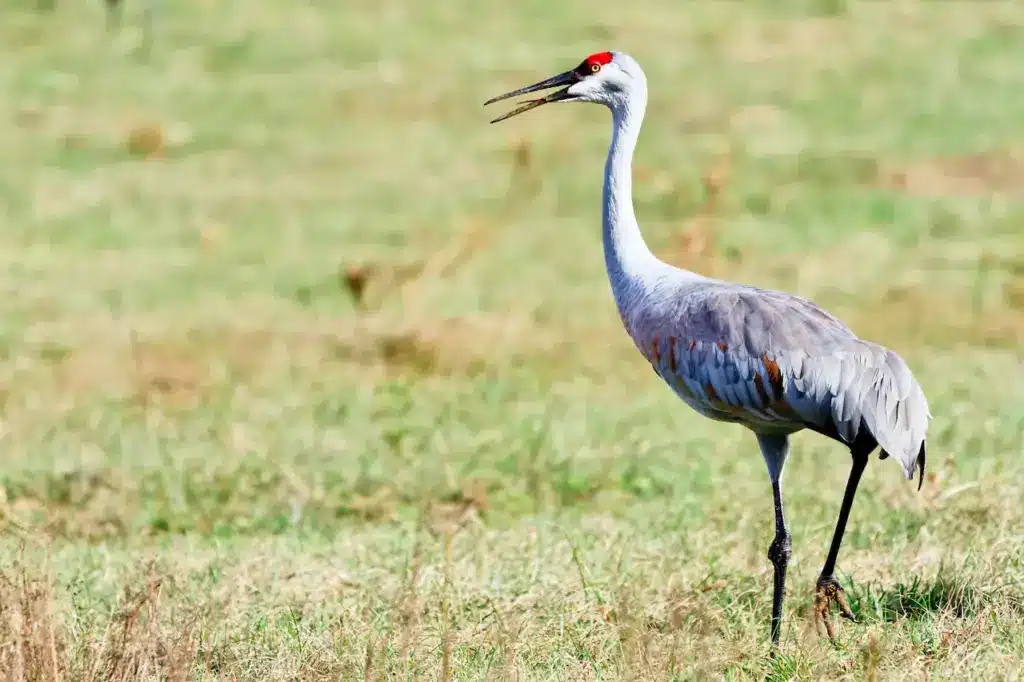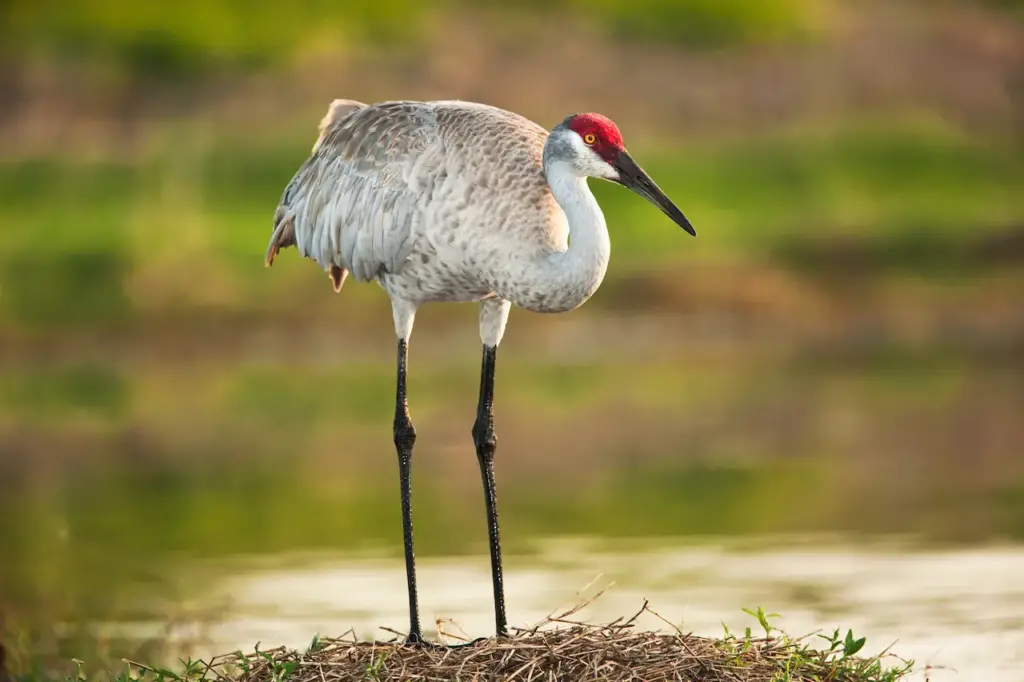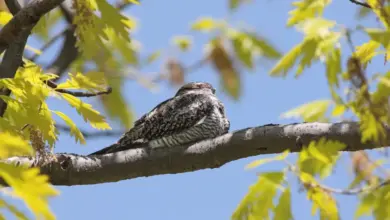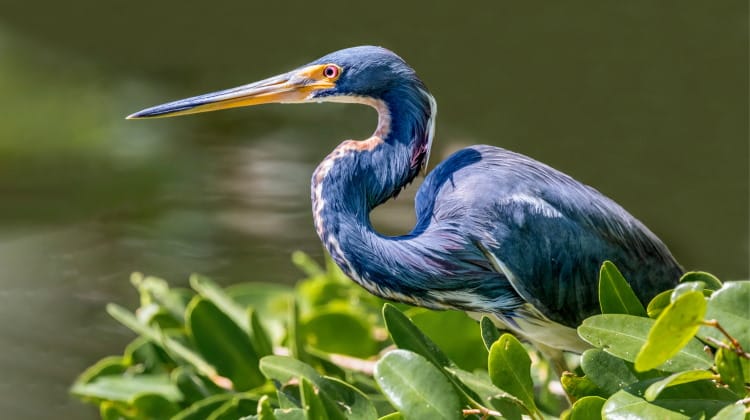The Sandhill Cranes (Grus canadensis) is a large crane of North America and extreme northeastern Siberia.
The common name of this bird references habitat like that at the Platte River, on the edge of Nebraska’s Sandhills in the American midwest.
This is the most important stopover area for the Lesser Sandhill Crane, Grus (canadensis) canadensis, with up to 450,000 of these birds migrating through annually.

Sandhill Cranes Description:
Adults are gray overall; during breeding, the plumage is usually much worn and stained, particularly in the migratory populations, and looks nearly ochre. The sandhill crane has a red forehead, white cheeks and a long dark pointed bill.
Its long dark legs trail behind in flight, and the long neck is kept straight in flight. Immature birds have reddish brown upperparts and gray underparts.
The sexes look alike. Size varies among the different subspecies.
This crane frequently gives a loud trumpeting call that suggests a French-style “r” rolled in the throat, and they can be heard from a long distance.
Mated pairs of cranes engage in “unison calling.” The cranes stand close together, calling in a synchronized and complex duet. The female makes two calls for every single call of the male.
The only other large grayish-bodied bird of North America is the Great Blue Heron. This heron is of similar dimensions to the Sandhill Crane and is sometimes mistakenly called a crane, even though it is very different in plumage details and build. Like other herons, it flies with its neck tucked toward the body.
The sandhill crane’s large wingspan which is 6-8 feet when fully grown makes this a very skilled soaring bird similar in style to hawks and eagles. Utilizing thermals to obtain lift, they can stay aloft for many hours, requiring only occasional flapping of their wings and consequently expending little energy.
With migratory flocks containing hundreds of birds, they can create clear outlines of the normally invisible rising columns of air (thermals) that they ride.
Although it is rare, some Sandhill Cranes have been spotted devouring their young. If the mated pair recognizes a weakness in a young bird, they will eat it.
Sandhill Cranes Distribution and Habitat
Their breeding habitat is marshes and bogs in central and northern Canada, Alaska, part of the midwestern and southeastern United States and Siberia. They nest in marsh vegetation or on the ground close to water.
The female lays two eggs on a mound of vegetation. Cranes mate for life; both parents feed the young, called colts, who are soon able to feed themselves.
The Sandhill Crane does not breed until it is two to seven years old. It can live up to 25 years in the wild; in captivity they have been known to live more than twice that span. Mated pairs stay together year round, and migrate south as a group with their offspring.
Birds on the Gulf of Mexico are permanent residents. Others migrate to the southwestern United States south to Mexico. The Platte River at the edge of Nebraska’s Sandhills in the American midwest is an important stopover for up to 450,000 of these birds during migration. This crane is a very rare vagrant to western Europe.
These birds forage while walking in shallow water or in fields, sometimes probing with their bills. They are omnivorous, eating insects, aquatic plants and animals, rodents,livestock, seeds and berries. Outside of the nesting season, they forage in large flocks, often in cultivated areas.
This crane frequently gives a loud trumpeting call that suggests a French-style “r” rolled in the throat. Sandhill Cranes in flight can be differentiated from herons in that they fly with their necks extended and by their nearly constant calls.
Sandhill Cranes have been used as foster parents for Whooping Crane eggs and young in reintroduction schemes for that species, a project which failed as these foster-raised Whooping Cranes did not recognise other Whooping Cranes as their conspecifics (members of, or belonging to, the same species)—attempting instead, unsuccessfully, to pair with Sandhills.

Subspecies and evolution
There is considerable variation in size (much of which is clinal) and in migratory habits. A male of G. c. canadensis averages 7.4 lbs (3.34 kg), 39 in (98 cm) in length and has a wingspan of 5.3 ft (1.6 m). A male of G. c. tabida averages 11 lbs (5 kg), 47 in (119 cm) in length and has a wingspan of 7 ft (2.12 m). The southern subspecies (along with G. c. rowani) are intermediate, roughly according to Bergmann’s Rule.
Three subspecies are resident; pulla of the Gulf Coast of the U.S., pratensis of Florida and Georgia and nesiotes of Cuba. The northern populations exist as fragmented remains in the contiguous U.S. and a large and contiguous population from Canada to Beringia. These migrate to the southwestern United States and Mexico. This crane is a rare vagrant to China, South Korea and Japan and a very rare vagrant to western Europe.
Six subspecies have been recognized in recent times:
- Lesser Sandhill Crane, Grus canadensis canadensis
- Cuban Sandhill Crane, Grus canadensis nesiotes – ESA: Endangered
- Florida Sandhill Crane, Grus canadensis pratensis– ESA: Endangered
- Mississippi Sandhill Crane, Grus canadensis pulla – ESA: Endangered
- Canadian Sandhill Crane, Grus canadensis rowani
- Greater Sandhill Crane, Grus canadensis tabida
The Canadian Sandhill Crane is morphologically not reliably distinct and was never unequivocally accepted as valid subspecies. The other can be somewhat more reliably distinguished in hand by measurements and plumage details, apart from the size differences already mentioned. Unequivocal identification often requires location information, which is often impossible in migrating birds.
Analysis of control region mtDNA haplotype data shows 2 major lineages, one including the Lesser Sandhill Crane or Little Brown Crane, the Arctic and the subarctic migratory population. The other lineages can be divided into a migratory and some indistinct clusters which can be matched to the resident subspecies.
The Lesser and Greater Sandhill Cranes are quite distinct, their divergence dating roughly to some time during the Late Pliocene or Early Pleistocene, some 2.3–1.2 million years ago (mya).
It seems as if glaciation fragmented off a founder population of the Lesser Sandhill Crane, because during each major ice age its present breeding range was frozen year-round.
Still, Sandhill Cranes are amply documented from fossil and subfossil remains right to the modern era.
Conceivably, they might be considered distinct species already, a monotypic G. canadensis and the Greater Sandhill Crane G. pratensis, which would include the other populations.
It appears as if the scant differences between southern Canadian and western U.S. populations result from genetic drift due to the recent reduction in population and range fragmentation; until the early 20th century the southern migratory birds occupied a much larger and continuous range. Thus, the subspecies rowani may well be abandoned.
The two southern U.S. resident populations are somewhat more distinct, while the Cuban population has been comparatively little studied but appears to have been established on the island for a long time.
These and the migratory Greater Sandhill Crane proper form a group of lineages that diverged much more recently from a range in the southern U.S. and maybe northern Mexico, where they would have been resident.
The southern migratory population would then represent a later re-expansion which (re-)evolved their migratory habits independent from the northernmost birds, the geographically separated populations expanding rapidly in numbers when more habitat was available as the last ice age ended.
Breeding / Nesting
Their breeding habitat is marshes and bogs in central and northern Canada, Alaska, part of the midwestern and southeastern United States, Siberia and Cuba.
They nest in marsh vegetation or on the ground close to water. The female lays two eggs on a mound of vegetation, but it is rare that both chicks hatch and grow to independence.
Cranes mate for life; both parents feed the young, called “colts”, who are soon able to feed themselves. The colts are taught to fly over many weeks when they run and dance with their parents. Dancing is a significant component in the education of young cranes.
The Sandhill Crane does not breed until it is two to seven years old, and the average generation time is 12.5 years.
It can live up to 25 years in the wild; in captivity it has been known to live more than twice that span. Mated pairs stay together year-round and migrate south as a group with their offspring.

Predators
Eggs and nestling cranes are eaten by crows, ravens, wolves, foxes, coyotes, jackals, hawks, eagles, and raccoons.
Adult cranes are preyed on by foxes, coyotes, eagles, wolves, bobcats, and large owls. When approached by an avian predator, sandhill cranes will fly at the predator, kicking at it with their feet.
When aware of a mammalian predator, sandhill cranes move toward the predator with their wings spread and their bill pointed at the predator.
If the predator persists, sandhill cranes will attack, hissing, stabbing with their bills and kicking with their feet. The cranes tend to be more aggressive while protecting their young.
Mammalian predators are generally more likely to prey on adult cranes while they are distracted by nesting.
Diet / Feeding
These birds forage while walking in shallow water or in fields, sometimes probing with their bills. They are omnivorous, eating insects, aquatic plants and animals, rodents, seeds and berries.
Outside of the nesting season, they forage in large flocks, often in cultivated areas. In many western states and provinces of Canada, Sandhill Cranes are hunted during waterfowl seasons. The meat is reportedly among the better-tasting gamebirds.
The Florida subspecies is often seen in residential yards, and these birds seem a little afraid of human approach. These visitors will eat shelled corn and commercially purchased bird seed from the ground and from feeders.
They may be seen in yards in north-central Florida virtually year-round, often in pairs that may be accompanied by a juvenile.





